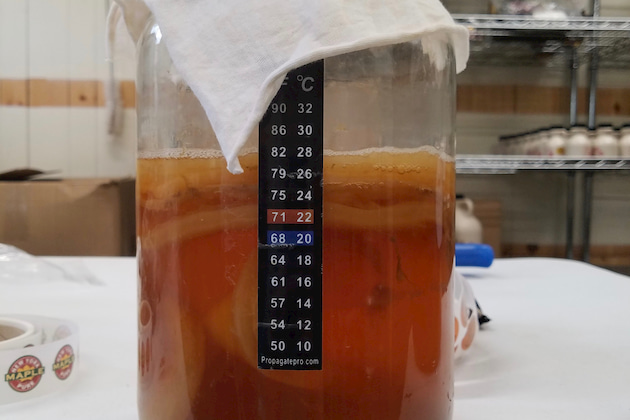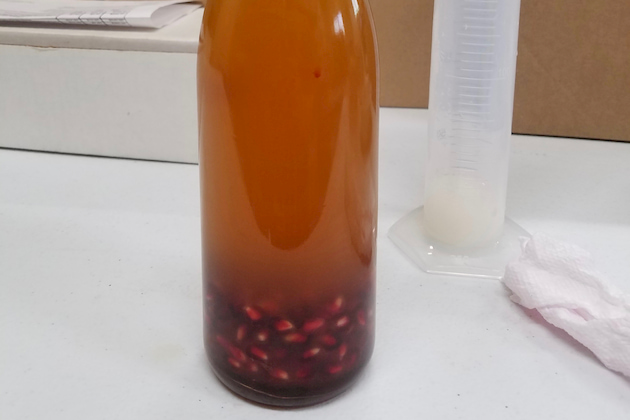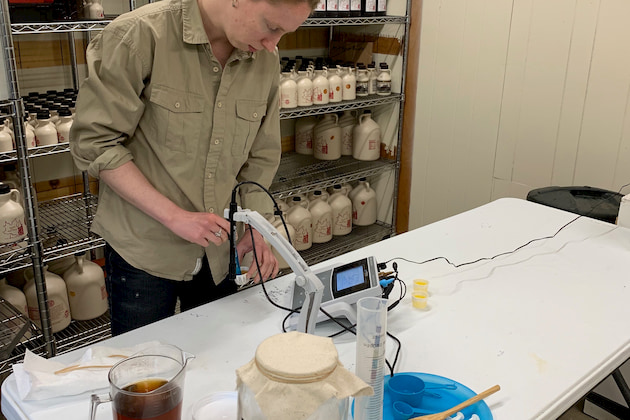Cornell Corner
Maple kombucha could be a next big thing
Popular new beverage sweeping the nation
By AILIS CLYNE, CORNELL MAPLE PROGRAM | SEPTEMBER 6, 2019
VAN ETTEN, N.Y.—Kombucha is the new health beverage craze that is sweeping the nation, and the newest value-added opportunity for maple producers.
Market research suggests a growth rate of 23 percent reaching a market worth of up to $5.45 billion by 2025.
Yet, no big players are brewing with maple.
Kombucha is so new on the scene that much of its growth is attributed to the development of new flavors.
At the Arnot Research Forest, part of the Cornell Maple Program at Cornell University, we have experimented with and fine-tuned a process for brewing kombucha with maple syrup and the results have gotten overwhelmingly positive reviews.
Kombucha is a refreshing, bubbly drink made by fermenting sweet tea.
It is an ancient beverage of East Asian origin that has been consumed all over the world for thousands of years. However, it has only recently gained commercial success in the U.S.
The popularity of the drink has a lot to do with the growth of the health and wellness industry. Finished kombucha is loaded with probiotics and antioxidants and is low in sugar, despite requiring loads of sugar in the early stages of fermentation.
This is where maple comes in.
The flavor and the process of making kombucha is very similar to those of vinegar. Vinegar is made in two steps.
1. Ferment sugar into alcohol. 2. Ferment the alcohol into acetic acid and water.
These two steps take months. In contrast, kombucha fermentation rolls both steps into one, taking much less time and less work.
This is all made possible by the kombucha culture, also known as, the SCOBY: Symbiotic Culture of Bacteria and Yeast.
It sounds alien and it even looks alien but this strange and ancient beverage has become mainstream, especially with young and health-conscious consumers.
The market for this refreshing beverage is rapidly expanding, and now is a great time to get brewing.
The consumer profile for this product gives maple producers a leg-up on the competition.
Kombucha consumers are typically concerned with buying local and sustainably produced products, even more so than they are concerned with cost.
Cane sugar, even when listed as “raw, organic”, simply cannot compete with pure maple.
This is not just an assumption.
We conducted surveys asking kombucha consumers their thoughts on informative product labeling. 100% of respondents said that they would be “extremely likely” to choose a maple-based kombucha over competitors if the words, “brewed with unrefined maple from sustainably managed woods,” were printed on the label.
Additionally, because kombucha is marketed as a health beverage, producers fermenting with maple should be sure to boast about the vitamin and mineral content of maple syrup for an extra edge.
Making kombucha is very simple. Just combine warm, sweet tea with finished kombucha from a previous batch, and top it off with a Scoby. Then, let it sit undisturbed at room temperature for about ten days. The Scoby does most of the leg work.
Traditionally, brewers use black tea and sweeten with cane sugar, but there are many other tea blends and sugar sources that work just as well.
Unfortunately, several resources online mistakenly claim that it is either not possible, or very difficult to brew kombucha with alternatives to cane sugar.
On the contrary, we found that the kombucha culture adapts easily to maple syrup producing a delicious, and in many ways superior, final product.
Despite the inputs, finished kombucha has hardly any sugar or caffeine, so it won’t taste particularly mapley on its own. There are subtle maple characteristics in the flavor profile of the finished brew, but the difference would only be perceptible to an avid kombucha drinker.
For more maple flavor, you would need to add maple during the flavor infusion step of making this beverage.
However, keep in mind, the typical kombucha drinker is not looking for an overly sweet product. They are in it for the trees, the minerals, and the support of local agriculture.
Usually, the finished product is sweetened with fresh fruit, and sometimes spices or herbal teas.
We found that several flavors pair really well with maple. Pear Maple Ginger, Maple Chai Spice, and Maple Mango were our most popular flavors, but the possibilities are endless. Even the unflavored version went over very well.
Kombucha is versatile in several other ways, too. You can make it sweet or savory. A soft drink, or a slightly boozy beverage (up to about 1.5% ABV). Full of fizz or totally flat. There’s a consumer for everything in between.
Because there are so many possibilities for brewing kombucha, it is easy to be unique. As of right now, simply using maple syrup as the fermentable sugar will make your beverage stand out from the crowd.
It’s that easy.


































